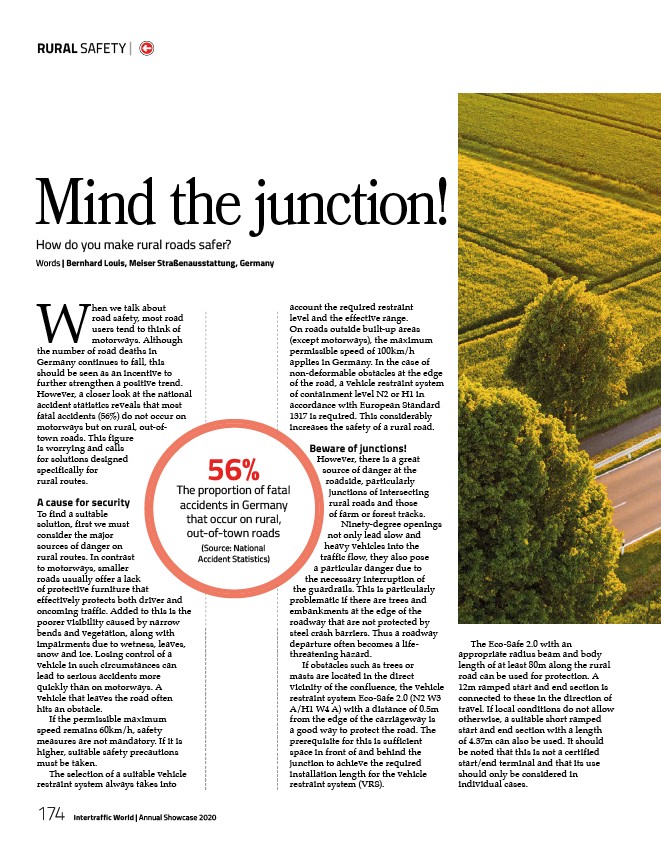
RURAL SAFETY |
Mind the junction!
How do you make rural roads safer?
Words | Bernhard Louis, Meiser Straßenausstattung, Germany
When we talk about
road safety, most road
users tend to think of
motorways. Although
the number of road deaths in
Germany continues to fall, this
should be seen as an incentive to
further strengthen a positive trend.
However, a closer look at the national
accident statistics reveals that most
fatal accidents (56%) do not occur on
motorways but on rural, out-oftown
roads. This figure
is worrying and calls
for solutions designed
specifically for
rural routes.
A cause for security
To find a suitable
solution, first we must
consider the major
sources of danger on
rural routes. In contrast
to motorways, smaller
roads usually offer a lack
of protective furniture that
effectively protects both driver and
oncoming traffic. Added to this is the
poorer visibility caused by narrow
bends and vegetation, along with
impairments due to wetness, leaves,
snow and ice. Losing control of a
vehicle in such circumstances can
lead to serious accidents more
quickly than on motorways. A
vehicle that leaves the road often
hits an obstacle.
If the permissible maximum
speed remains 60km/h, safety
measures are not mandatory. If it is
higher, suitable safety precautions
must be taken.
The selection of a suitable vehicle
restraint system always takes into
174 Intertraffic World | Annual Showcase 2020
account the required restraint
level and the effective range.
On roads outside built-up areas
(except motorways), the maximum
permissible speed of 100km/h
applies in Germany. In the case of
non-deformable obstacles at the edge
of the road, a vehicle restraint system
of containment level N2 or H1 in
accordance with European Standard
1317 is required. This considerably
increases the safety of a rural road.
Beware of junctions!
However, there is a great
source of danger at the
roadside, particularly
junctions of intersecting
rural roads and those
of farm or forest tracks.
Ninety-degree openings
not only lead slow and
heavy vehicles into the
traffic flow, they also pose
a particular danger due to
the necessary interruption of
the guardrails. This is particularly
problematic if there are trees and
embankments at the edge of the
roadway that are not protected by
steel crash barriers. Thus a roadway
departure often becomes a lifethreatening
hazard.
If obstacles such as trees or
masts are located in the direct
vicinity of the confluence, the vehicle
restraint system Eco-Safe 2.0 (N2 W3
A/H1 W4 A) with a distance of 0.5m
from the edge of the carriageway is
a good way to protect the road. The
prerequisite for this is sufficient
space in front of and behind the
junction to achieve the required
installation length for the vehicle
restraint system (VRS).
The Eco-Safe 2.0 with an
appropriate radius beam and body
length of at least 80m along the rural
road can be used for protection. A
12m ramped start and end section is
connected to these in the direction of
travel. If local conditions do not allow
otherwise, a suitable short ramped
start and end section with a length
of 4.37m can also be used. It should
be noted that this is not a certified
start/end terminal and that its use
should only be considered in
individual cases.
56% The proportion of fatal
accidents in Germany
that occur on rural,
out-of-town roads
(Source: National
Accident Statistics)